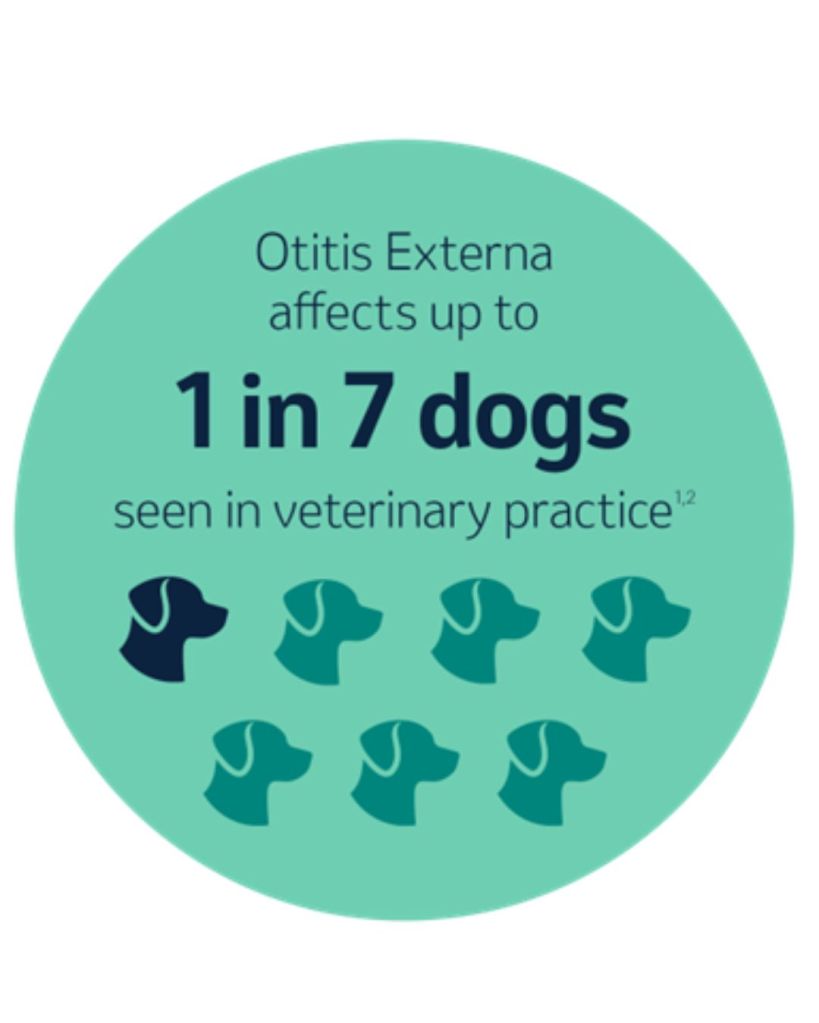
Canine Otitis Externa in Dogs: Prevalence, Symptoms, and Care
The Final Rabies Generation

Canine Otitis Externa, commonly referred to as ear inflammation, is a prevalent condition affecting dogs of all breeds and ages. Research indicates that up to 1 in 7 dogs seen in veterinary practice will get otitis externa at some point in their lives.1,2 Pet owners should be vigilant about their dogs’ ear health, as early detection and treatment can significantly improve outcomes and enhance their pets’ quality of life. This condition not only causes discomfort and pain for our furry companions but can also lead to more severe health issues if left untreated. There are several causes of otitis externa with the most common being allergies to something within their environment and sometimes even food.3,4Canine Otitis Externa, commonly referred to as ear inflammation, is a prevalent condition affecting dogs of all breeds and ages. Research indicates that up to 1 in 7 dogs seen in veterinary practice will get otitis externa at some point in their lives.1,2 Pet owners should be vigilant about their dogs’ ear health, as early detection and treatment can significantly improve outcomes and enhance their pets’ quality of life. This condition not only causes discomfort and pain for our furry companions but can also lead to more severe health issues if left untreated. There are several causes of otitis externa with the most common being allergies to something within their environment and sometimes even food.3,4
Other causes of otitis externa may include5 :
- Parasites
- Foreign objects in ear canal
- Skin disorders
- Other diseases
- Swimming or activities that introduce water into ears.
Signs & Symptoms
An evaluation from a veterinarian for otitis and its diagnosis is based on ear canal palpation, visual inspection of both ears, including otoscopic examination and cytological analysis of otic contents.
Pet owners should be vigilant for the following common symptoms of otitis externa:
- Rubbing or scratching of the ears: Dogs may frequently paw at or rub their ears against surfaces.
- Head shaking: Excessive shaking of the head can indicate discomfort.
- Pain or discomfort: Dogs may show signs of distress when their ears are touched.
- An unpleasant odor or discharge from the ears: A foul smell or unusual discharge from the ears is often a sign of infection.
In addition to behavioral changes, visible symptoms to the outer ear may include6:
- Alopecia: Hair loss around the ears.
- Excoriation: Red, irritated skin due to scratching.
- Crusting: Formation of crusts or scabs on the ear surface.
- Erythema and hyperpigmentation: Redness and darkening of the skin around the ears.
Treating Otitis Externa
To treat these conditions, a veterinarian will identify and correct any underlying causes as well as determine necessary treatments such as topical therapy, anti-inflamatory therapy and/or antimicrobial therapy. Prior to treatment, fur around the ear is clipped off, as well as inside the ear canal to improve the cleaning and treatment of the ears. Cleaning ears before topical therapy is critical in helping decrease otic cerumen and increase the effectiveness of topical therapy. Ear cleaning also helps break up the biofilm that may protect bacterial colonies from appropriate antimicrobial therapy.
Throughout treatment, follow-up evaluations should be scheduled (including palpation, otoscopic examination, and ear canal cytology) to ensure perpetuating or primary factors are not present at the time of completion of therapy.
Preventative Care
Regular ear cleaning and inspection is essential, especially for dogs prone to ear issues. Be sure to look out for any unusual temperature changes, changes in skin color or condition, sudden increases in moisture, or other changes. Additionally, monitoring for symptoms such as scratching or unusual odors allows for early detection and prompt treatment. Managing underlying allergies, whether food-related or environmental, is vital, as these can contribute to ear problems. After bathing or summertime swimming, it is important to thoroughly dry the ears to prevent moisture buildup, which can lead to infections.
Routine veterinary check-ups are also recommended to monitor ear health and provide professional cleaning. Lastly, proper grooming practices, especially for dogs with long or floppy ears, can help prevent matting and moisture retention. By implementing consistent routine, consistent treatment options and preventive measures, pet owners can significantly reduce the risk of otitis externa, ensuring their dogs remain comfortable and healthy.
References:
- Perry, L. R., MacLennan, B., Korven, R., et al. “A Retrospective Study of the Clinical Presentation and Treatment of Canine Leptospirosis in Ontario, Canada.” Canadian Veterinary Journal, vol. 58, 2017, pp. 168 174.
- O’Neill, D. G., Church, D. B., McGreevy, P. D., et al. “Prevalence of Disorders Recorded in Dogs in the UK Veterinary Practices.” PLoS One, vol. 9, 2014, e90501.
- Hnilica, K. A. Small Animal Dermatology: A Color Atlas and Therapeutic Guide. 4th ed., Elsevier, 2017, pp. 416-430.
- Zur, G., Lifshitz, B., Bdolah-Abram, T. “The Effect of a Topical Antiseptic on the Bacterial Flora of the Skin of Dogs.” Journal of Small Animal Practice, vol. 52, 2011, pp. 254-258.
- Moriello, Karen A., DVM, DACVD. “Ear Infections and Otitis Externa in Dogs.” Merck Veterinary Manual, Merck & Co., Inc., 2024, Department of Medical Sciences, School of Veterinary Medicine, University of Wisconsin-Madison, www.merckvetmanual.com/dog-owners/ear-disorders-of-dogs/ear-infections-and-otitis-externa-in-dogs?query=otitis%20externa%20dog.
- Bajwa J. Canine otitis externa – Treatment and complications. Can Vet J. 2019 Jan;60(1):97-99. PMID: 30651659; PMCID: PMC6294027. https://pmc.ncbi.nlm.nih.gov/articles/PMC6294027/
